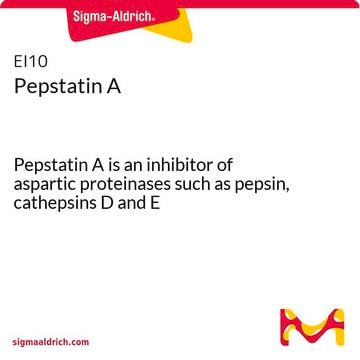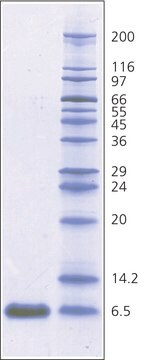11004638001
Roche
Chymostatin
Synonym(e):
N-(Nα-Carbonyl-Cpd-X-Phe-al)-Phe (Cpd = Capreomycin) (Capreomycin = [S,S]-α-(2- Iminohexahydro-4-pyrimidyl) glycin)
About This Item
Empfohlene Produkte
Form
powder
Qualitätsniveau
Mol-Gew.
Mr = 607.71
Verpackung
pkg of 10 mg
Hersteller/Markenname
Roche
mp (Schmelzpunkt)
205 °C
Löslichkeit
acetic acid: soluble 20 mg/mL
Lagertemp.
2-8°C
SMILES String
OC(C(NC(NC(C1NC(NCC1)=N)C([F,Cl,Br,I]C)=O)=O)CC2=CC=CC=C2)=O
InChIKey
MRXDGVXSWIXTQL-HYHFHBMOSA-N
Suchen Sie nach ähnlichen Produkten? Aufrufen Leitfaden zum Produktvergleich
Allgemeine Beschreibung
Anwendung
Biochem./physiol. Wirkung
Qualität
Alternative Formulierung
Angaben zur Herstellung
1 U chymotrypsin is inhibited to 49% of the original activity by 1.8 μg of chymostatin.
Thin-layer chromatography: butanol/methanol/H2O = 4 / 1 / 2
Working solution: Soluble in glacial acetic acid or DMSO to 20 mg/ml. Sparingly soluble in water, methanol, or ethanol. Insoluble in ethyl acetate, petroleum and ethyl ethers, hexane, or chloroform (CHCl3).
It is recommended to dissolve the inhibitor in 1% acetic acid in higher concentration and to adjust the concentration wanted with phosphate buffer, 0.05 M, pH 7.0, which is common for chymotrypsin assay.
CAUTION: DMSO (Dimethyl sulfoxide) will permeate the skin, carrying solubilized protease inhibitors. Always wear appropriate protection for eyes, skin, etc.
Storage conditions (working solution): -15 to -25 °C
Dilute solutions should be stored frozen in aliquots at -15 to -25 °C and are stable for approximately one month. Avoid repeated freezing. Growth of microorganisms should be avoided as proteases from microbial origin may hydrolyze the peptides.
Sonstige Hinweise
Lagerklassenschlüssel
11 - Combustible Solids
WGK
WGK 1
Flammpunkt (°F)
Not applicable
Flammpunkt (°C)
Not applicable
Analysenzertifikate (COA)
Suchen Sie nach Analysenzertifikate (COA), indem Sie die Lot-/Chargennummer des Produkts eingeben. Lot- und Chargennummern sind auf dem Produktetikett hinter den Wörtern ‘Lot’ oder ‘Batch’ (Lot oder Charge) zu finden.
Besitzen Sie dieses Produkt bereits?
In der Dokumentenbibliothek finden Sie die Dokumentation zu den Produkten, die Sie kürzlich erworben haben.
Kunden haben sich ebenfalls angesehen
Unser Team von Wissenschaftlern verfügt über Erfahrung in allen Forschungsbereichen einschließlich Life Science, Materialwissenschaften, chemischer Synthese, Chromatographie, Analytik und vielen mehr..
Setzen Sie sich mit dem technischen Dienst in Verbindung.














